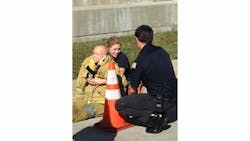Editor's Note: Firehouse welcomes former Fire Chief magazine Editor-in-Chief Janet Wilmoth with her new blog, "Just Janet." Follow Janet as she shares her experiences from more than 25 years covering the fire service. Find more from Janet here.
How many of you wanted to be a firefighter when you grew up? I asked this question at the Springfield, Mo., Fire Department's "Girls on Fire" recruiting program for young women last weekend. Of the 18 women participating in the one-day program, five raised their hands and said they were volunteers in local fire departments. I thought that was pretty impressive.
Springfield Fire Department has 208 men firefighters, two women, and a third will graduate the academy in late December. The training division recently decided to host a forum for women to learn more about a career in firefighting and to try their hand at some of the tasks firefighters perform during testing and on the job.
The morning began with a representative from human resources explaining the application and hiring process, which could take up to eight months. The next speaker, from a local career resource center, distributed handouts on the do's and don'ts to create a resume and to interview for a job.
Shay Mason, an African American woman who is the fire chief at the St. Robert Fire Department, about 90 miles away, shared what it was like to be a soldier-turned-firefighter and eventually a fire chief in a combination fire department in rural Missouri. "I just wanted to drive a fire truck. That's all," Mason said. But she quickly learned she had to become a firefighter to drive a fire truck. An avid student, Mason told the attendees that education was her focus and continues to be in the ever-changing emergency services field. "I'm testing for paramedic soon," she added.
One young woman and volunteer firefighter in a nearby department raised her hand and said, "Women aren't allowed to drive fire trucks in our department." Hello? What year is it?
My role in the program was to talk about the opportunities and challenges facing the fire and emergency services and why women should consider becoming firefighters. Among the opportunities are a broad range of specialty areas where firefighters can develop an expertise: paramedics, operations, hazmat/CBRN, investigation, rescue, safety, etc. Even public information officers are taking on more assertive roles as external affairs officers and reaching out to market fire department services in their community.
I also talked about some of the new "hazards" to emergency responders including faster, hotter fires due to petroleum-based furnishings, increasing exposure to toxic chemicals, mental stress and smart phones now able to track firefighters on and off duty.
With stories from two women firefighters, I shared the sense of satisfaction they felt responding to help someone who is having the worst day of their life and the camaraderie from being part of a trained, dedicated team that does that every shift.
I've had the opportunity to meet hundreds of women firefighters, officers and chiefs that are dedicated and capable to do the job and serve their community--and I wouldn't trade jobs with them for anything.
While I have not served as a firefighter, in the early 70's I was the first female hired in Illinois for outside sales for United Parcel Service (UPS). A male-dominated company, traditionally promotions only came after driving a "package car" (brown truck) and I did not. UPS was only in 26 states at that time and growing rapidly. It was an exciting time to be part of the company, yet the frustrations I encountered would never compare to the life-threatening harassment some firefighters experience.
Isn't the bottom line, if you are physically able and trained to do a job, then just do it?
According to the International Association of Women in Fire and Emergency Services website, there are eleven different camps and programs, ranging from one day to five days, for young women to learn about the skills and education necessary to become a firefighter. Some of the programs even partner with the Girl Scouts of America. These efforts are organized by fire departments that know the value of a diverse department that reflects the community it serves.
As I stood outside and watched these young women take turns learning the right way to pull up a 35-foot ladder, rappel down the side of a building, gear up for a smoke-filled room or drag a 180-pound dummy, I didn't see one of them flinch or back-off.
How many of the "Girls on Fire" will follow through and become firefighters? I don't know. I do know the door is open in Springfield.






